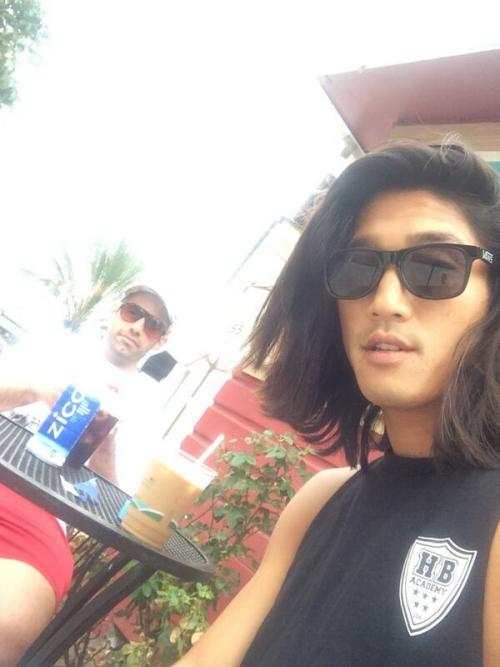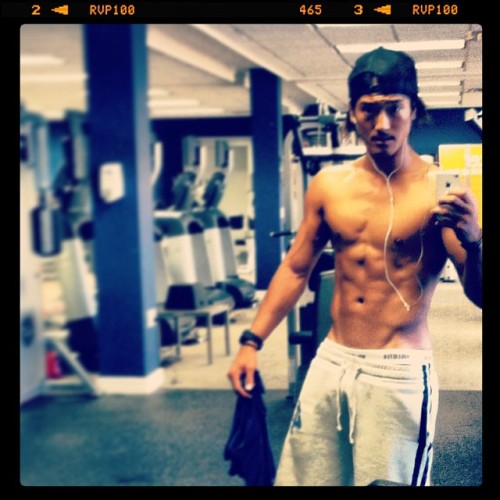#korean american

In 2000,Hong Seok-cheon was at the height of his career. The South Korean actor had starred in the wildly popular sitcom Three Guys and Three Girls, was host of a primetime variety show and even had his own radio program. Then came a surprise announcement: while appearing on a Korean talk show, Hong revealed he was gay.
In South Korea, the response to the actor’s coming out was immediate and harsh. He was fired from his hosting and acting gigs and received multiple death threats. As he later told the LosAngeles Times in 2012, Hong struggled with the fallout: he started to drink heavily and at one point contemplated suicide. Still, after years of hiding in the closet, something clicked for the actor, who was the first South Korean celebrity to openly acknowledge he was gay. “If I think I’m right, even though other people are against something, I get upset. And I fight,” he told theTimes.
ForKim Ji-hoo, a well-known fashion model in South Korea, the fight was short-lived. In 2007, Kim came out as gay. He was immediately fired from all his upcoming fashion shows and TV appearances. Two years later, the 23-year-old committed suicide by hanging himself at his home, leaving behind a suicide note stating that he was lonely and in a difficult situation.
Spreading awareness about gay identity in South Korea’s conservative society is not easy; homosexuality is neither openly discussed nor acknowledged. Even today, years after Hong’s admission and Kim’s death at such a young age, identifying as gay is still considered taboo in South Korea—and among the Korean community in the U.S. as well.
Read full article here.

by MARK EDWARD HARRIS
Several years ago, Andrea Lee traded a desk job as a corporate attorney in New York City to head Uri Tours, a New Jersey-based travel company founded by her family a decade ago, which organizes tours to North Korea. As its CEO and occasional tour leader, the 33-year-old Lee helps curious individuals see what life is like north of the 38th parallel on the divided Korean peninsula.
Although widely perceived as a sealed-off nation closed to foreign tourists, North Korea permits group and even private travel by citizens of any country other than South Korea who book through a tourism partner-provider. While the U.S. Department of State strongly recommends against travel by U.S. citizens to the Democratic People’s Republic of Korea, as the country is officially known, there appears to be no adverse impact on Uri’s business.
The only incident Uri, the largest American operator of North Korea tours, ever reported in its 10-year history occurred last year, when Matthew Miller, a 24-year-old from California, opted to take a private tour with only local North Korean guides and ripped up his tourist visa. He was arrested by North Korean officials for “hostile acts” but U.S. officials negotiated his release in November.

Bringing on average one thousand visitors to North Korea each year, Uri partners with a network of travel agents and resellers, as well as nonprofit organizations, nongovernmental organizations and universities in arranging North Korea tours. It facilitated the New York Philharmonic’s visit in February 2008 and Dennis Rodman’s much-publicized visit with Vicemedia in 2013. In addition, Uri is the exclusive ticketing agent for the Americas for North Korean state-run Air Koryo.
It hasn’t hurt that North Korea has looked more outwards in recent years, even opening the Pyongyang Marathon in 2014 and 2015 to foreign amateur runners.
Lee, who was born in Chile, travels at least once a month to North Korea to lead tours. KoreAm recently spoke with her by phone. The following is an edited transcript of the conversation.

How did your family get the idea to start Uri Tours?
Andrea Lee: My family had been traveling to North Korea since the 1990s, when we visited the country through a Korean American business association. North Korea was a natural curiosity to us, as it is for many Korean Americans. The more we traveled there, the more we learned that a lot of people back in the U.S. wanted an opportunity to visit. We were able to meet with travel companies within the DPRK and forge partnerships. We started to take people with us in small groups and over time, it grew to be a formal business.
Who typically signs up for your tours?
Because we’re an American company, over half of our clients are North American. We get a lot of European travelers and people from New Zealand and Australia as well.
What has it been like to visit North Korea as a Korean American?
People I meet there are often curious about my upbringing, asking me questions much like those I get in South Korea: Do you eat kimchi at home? Are you married? Do you speak Korean to your parents? As a Korean American myself, I am living proof that [North Korea] is a safe place for Korean [Americans] to visit so long as they follow the rules of the tour.

Read full article here.

During the recent unrest that spread across the city of Baltimore in the wake of the death of 25-year-old Freddie Gray, several hundred small businesses in the city were damaged, looted or burned down. Many of these stores—more than 50, by the estimate of the Korean American Grocers & Licensed Beverage Association of Maryland—were Korean-owned. These small business owners, mostly immigrants, are now left to grapple with the task of assessing their losses, in some cases irrevocable, while dealing with the physical and emotional toll of seeing years of hard labor destroyed.
Minna Kim, a Maryland resident, former elementary school teacher and soon-to-be masters student in clinical and medical social work, recounts the harrowing April 27 evening in which her parents, owners of a liquor store in West Baltimore, guarded their business, at any cost, as riots spread across the city.
* * *
by MINNA KIM
On April 22, I landed at Baltimore-Washington International Airport, blissed out and disoriented. I had spent the last two months in Bali for a yoga leadership training and in Thailand for a meditation retreat. As I disembarked from the plane, the fluorescent lights and stained carpets at the airport posed a stark contrast to the balmy lushness of Southeast Asia.
On the streets of my hometown, unrest was brewing. Only three days prior to my arrival, Freddie Gray died while in the custody of Baltimore police. Protests were forming. And five days later, shit hit the fan.
On Monday, April 27, the day of Gray’s funeral, my parents locked up their liquor store in West Baltimore around five in the afternoon. Closing before 10 p.m. was unusual for them. But their Korean friends who own a grocery store not too far from theirs called and urged them to leave the city because a riot had erupted at Mondawmin Mall, a little over a mile from the store.
Back home in our suburban neighborhood 20 minutes outside of the city, my parents beelined it to the television set. We sat transfixed, watching news coverage of Baltimore city engulfed in mayhem. Eventually, we tore ourselves away from the TV and went about our evening, shooing away any thoughts of misfortune that buzzed around our dinner conversation.
At 9:43 p.m., the alarm company phoned our home.
Without hesitation, my immigrant parents drove back to the store they have owned for nearly a decade. The backdoor had been pried open. Looters were flooding in and out of the store. Stalled outside, my father honked his car horn, upon which the looters shouted warnings to each other to “Hurry up!” and flee. At 10:06 p.m., my mother dialed 911 from the car. A voice recording said all lines were busy. Three minutes later, my mother tried 911 again: another unsuccessful attempt.
Undeterred and hyperalert, my badass mother got out of the car and ran the two blocks towards the nearest police station. Police officers were in riot gear; some were guarding the station. A female officer who appeared to be in charge told my mother they were not supposed to leave their assigned areas. My mother pleaded that her store was very close. Another officer recognized the address. As he began to get into his car with his partner, he told my mother they would stop by. She asked if she, too, should get in the car; they left her to walk back to the store.
Read full article here.
To celebrate this year’s Asian Pacific American Heritage Month, CAPE(Coalition of Asian Pacifics in Entertainment) has launched its 2015#IAM Campaign to put a spotlight on Asian American talents and leaders in media, entertainment and food.
Among the role models featured in this year’s campaign, there were several Korean American talents: Daniel Dae Kim,Ki Hong Lee,Arden ChoandSeoul Sausage Co. In the videos below, these four representatives share their success stories and the lessons they’ve learned in their journeys.
#IAM Ki Hong Lee
“The only way to change [Asian American perception] faster or to launch a new wave of how people see Asians is to create our own content, to create our own stories, and make opportunities for ourselves as actors and as entertainers,” says Ki Hong Lee. “I think the only way to change anything is to just take it and change it yourself.”
#IAM Arden Cho
“Don’t be afraid to fail because failure adds character and color and it’s those imperfections, flaws, and mistakes that you make along the way that add to a great story,” says Arden Cho.
Watch more #IAM videos here.
Soooo.. uh was I the only one who found Woo from Survivor attractive? I mean fuck, look at him.
Post link


